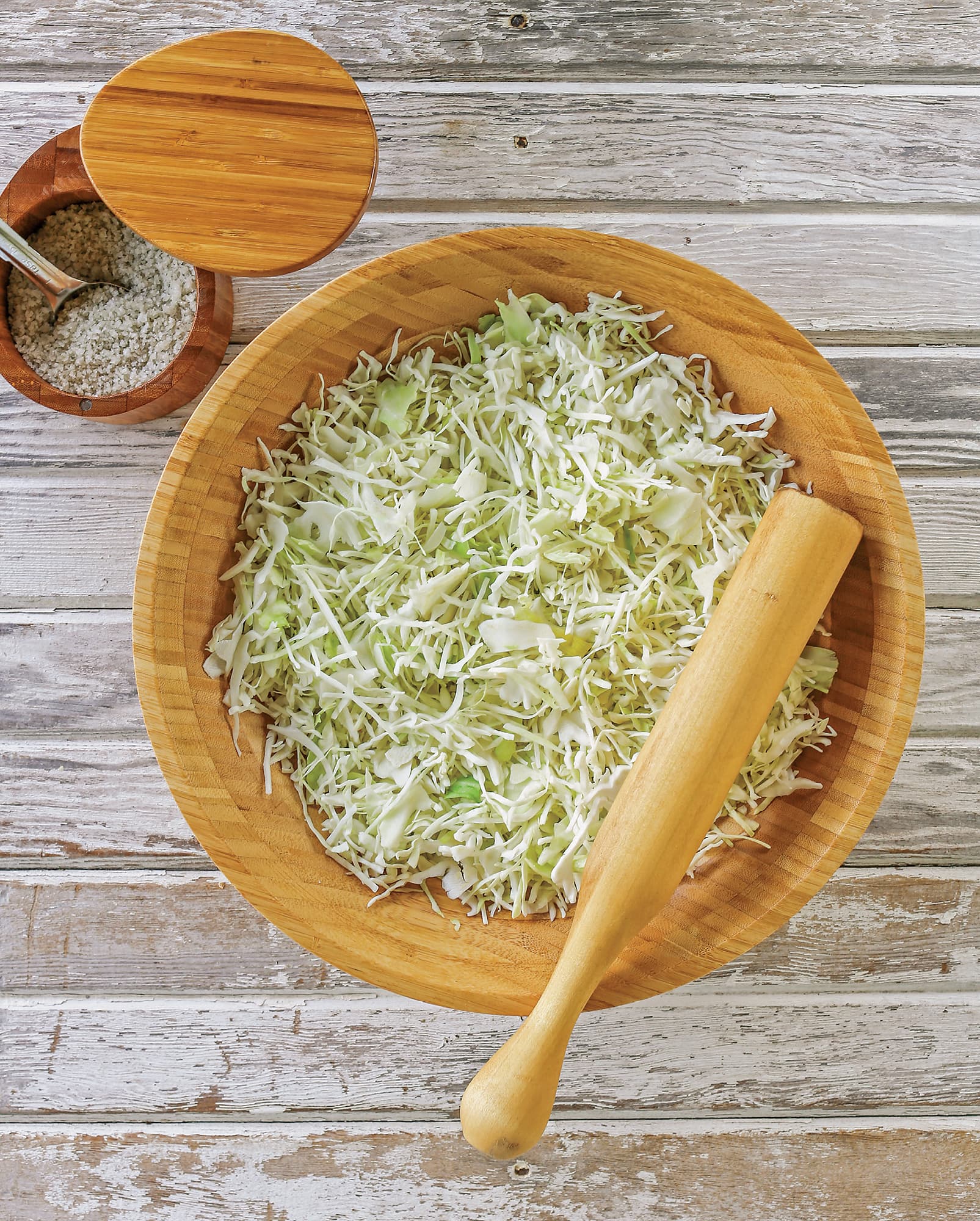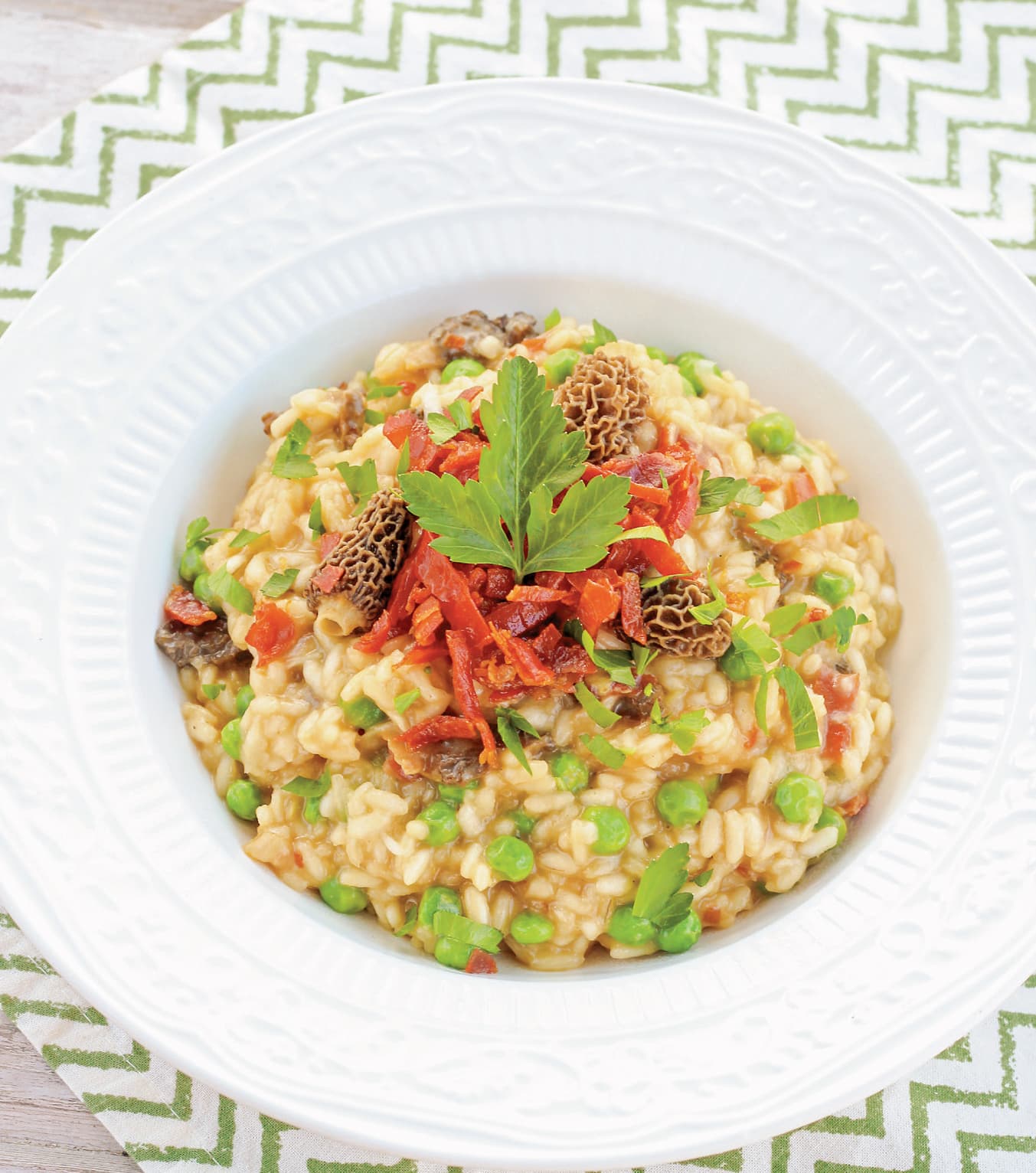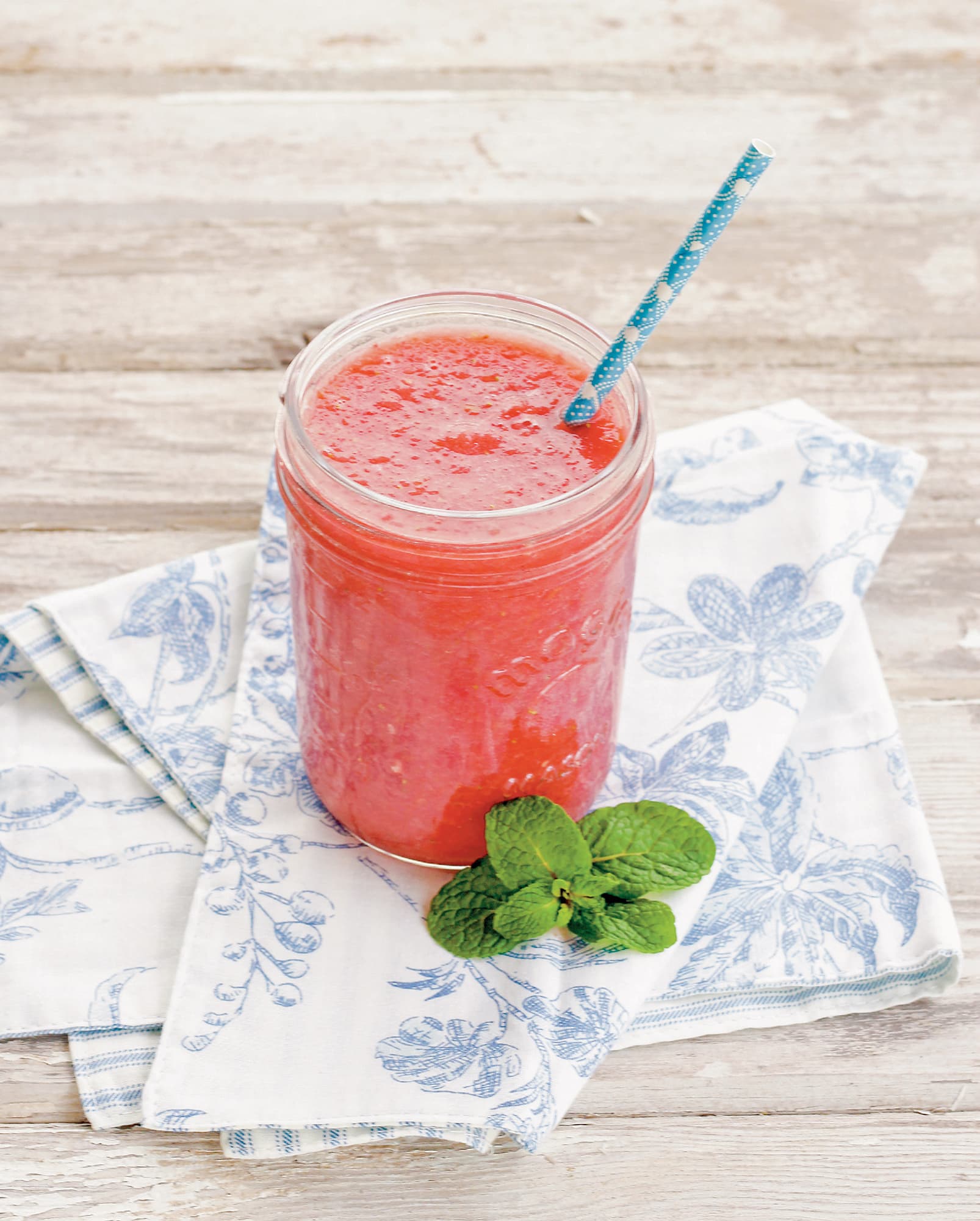Chapter 8
Sauerkraut

Many of us automatically think of Germany when we think of sauerkraut, and that’s probably because it’s widely considered to be the national dish there. Instead, it’s likely that it actually originated in China. The workers constructing the Great Wall of China were fueled by sauerkraut, and ancient Chinese leaders may have been the first to bring cabbage mixed with salt to Europe. The dish was quickly embraced by Europeans.
Europeans brought sauerkraut with them as they travelled by ship to the United States. They reportedly carried the fermented vegetable in a pickling crock. Sauerkraut supplied vitamin C fending off scurvy, which often plagued travelers on the long voyage.
The Amish and Mennonite communities living in the United States make traditional sauerkraut. Many of them are of Dutch or German descent, and you can still find the original recipe available in restaurants and for sale in markets in these communities.
Sauerkraut is made by finely shredding cabbage, mixing it with salt, and then allowing it to naturally ferment in the salted brine made from the juices the cabbage releases. Fully cured sauerkraut keeps for several months in an airtight container stored at 60°F (16°C) or below.
Raw sauerkraut is distinctly different from the store-bought, canned, or packaged varieties. Although many food manufacturers can or jar their kraut using heat to extend shelf life, raw sauerkraut is lacto-fermented and alive with good bacteria and probiotics.
Sauerkraut
YIELD: 1 TO 11/2 QUARTS (568 TO 852 G)
Not only is sauerkraut delicious, it’s also a bountiful source of nutrients. Rich in vitamins and probiotic bacteria, it’s a surprisingly healthful dish. The fermentation process helps make the nutrients more readily available to the body. The cabbage is rich in fiber and, along with the good bacteria, it can help improve digestion. This recipe is low in calories and satisfying, too.

EQUIPMENT YOU’LL NEED:
Cutting board
Large knife, mandoline, or food processor with fine slicing disk
Mixing bowl
1 glass 2-quart (1.9 L)wide-mouth canning jar (or two 1-quart (950 ml)jars)
Canning funnel (optional)
Pounder (optional) (See the Resources)
Smaller jar to use as a weight
Cheesecloth or cotton fabric square
Rubber band or string
INGREDIENTS:
1 medium head of green cabbage (about 3 pounds, or 1.4 kg)
11/2 tablespoons (23 g) sea salt
Discard the wilted, limp outer leaves of the cabbage. Cut the cabbage into quarters and trim out the core. Slice each quarter down its length, making 8 wedges. Slice each wedge crosswise into very thin ribbons using a knife, mandoline, or slicing disk in your food processor.
Transfer the cabbage to a large bowl and sprinkle the salt over the top. Work the salt into the cabbage by massaging and squeezing the cabbage with your hands. At first, it may not seem like enough salt, but gradually, the cabbage will become watery and limp—more like coleslaw than raw cabbage. This will take 5 to 10 minutes.
Take handfuls of the cabbage and pack them into the canning jar. If you have a canning funnel, this will make the job easier. Every so often, tamp down the cabbage in the jar with your fist or a pounder. Pour any liquid released by the cabbage while you were massaging it into the jar. If you like, place one of the larger outer leaves of the cabbage over the surface of the sliced cabbage. This will help keep the cabbage submerged in its liquid.
Once all the cabbage is packed into the jar, fill the smaller jelly jar with water and cover with a lid (to create weight). Slip it into the mouth of the larger jar. This will help keep the cabbage weighed down and eventually, submerged beneath its liquid.
Cover the mouth of the larger canning jar with a cloth and secure it with a rubber band or string. This allows air to flow in and out of the jar, but prevents dust or insects from getting into the jar.
Over the next 24 hours, press down on the cabbage every so often with the jelly jar. As the cabbage releases its liquid, it will become more limp and compact, and the liquid will rise over the top of the cabbage. If after 24 hours the liquid has not risen above the cabbage, dissolve 1 teaspoon salt in 1 cup (235 ml) water and add enough of this mixture to submerge the cabbage.
Ferment the cabbage for 3 to 10 days. As it’s fermenting, keep the sauerkraut away from direct sunlight and at a cool room temperature—ideally, 70°F (21°C). Check it daily and press it down if the cabbage is floating above the liquid. Because this is a small batch of sauerkraut, it will ferment more quickly than larger batches.
Start tasting it after 3 days. When the sauerkraut tastes good to you, remove the weight, screw on the cap, and refrigerate. The sauerkraut can continue fermenting for 10 days or longer. There’s no hard-and-fast rule for when is “done”—go by how it tastes.
While it’s fermenting, you may see bubbles coming through the cabbage, foam on the top, or white scum. These are all signs of a healthy, happy fermentation process. The scum can be skimmed off the top either during fermentation or before refrigerating. If you see any mold, skim it off immediately and make sure your cabbage is fully submerged; don’t eat the moldy parts close to the surface, but the rest of the sauerkraut is fine.
Store the sauerkraut in the refrigerator for several months. As long as it still tastes and smells good to eat, it will be. If you like, you can transfer the sauerkraut into smaller container for storage.
Mean Green Smoothie
YIELD: 2 (11/2 CUP, OR 355 ML) SERVINGS
This smoothie is the perfect blend of flavors—a tart green apple and herbal celery enhanced by the zing of ginger. You’re sure to feel better after your first sip of this smoothie, especially because it’s packed with fermented sauerkraut and probiotic-rich yogurt!
2 cups (60 g) spinach
1 large cucumber, sliced
1 celery stalk, chopped
1 green apple, cored and chopped
1 (1/2-inch, or 1.2 cm) piece of fresh ginger, peeled
1 cup (118 g) ice cubes
1/2 cup (115 g) plain (See Yogurt)
1/4 cup (36 g) (See Sauerkraut)
1 tablespoon (13 g) chia seeds
Juice of 1 lime
Juice of 1/2 of a lemon
In a blender, place the spinach, cucumber, celery, apple, ginger, ice, Yogurt, Sauerkraut, chia seeds, lime juice, and lemon juice. Puree for 1 minute or until smooth. Serve immediately.
Brussels Sprout and Sweet Potato Hash
YIELD: 4 SERVINGS
2 tablespoons (28 g) coconut oil
1 large sweet potato, peeled and cut into 1-inch (2.5 cm) cubes
1 pound (455 g) Brussels sprouts, trimmed, halved, or quartered
1 cup (235 ml) water
4 large eggs
1 cup (142 g) (See Sauerkraut)
Red pepper flakes and
sea salt, to taste
Maybe your morning routine includes just a quick bowl of cereal. I promise you will appreciate spending a few extra minutes on this breakfast. The sweet potatoes caramelize right in the pan filling your home with a welcoming aroma. This dish will entice everyone in the house to get out of bed and make a beeline to the table for a delicious sit-down meal.
Heat the oil in a large cast-iron skillet over medium-high heat. Add the sweet potato and cook undisturbed for 4 minutes.
Stir the sweet potato and then add the Brussels sprouts. Cook for 5 to 7 minutes until the vegetables are deeply browned, stirring every 2 minutes.
Add the water and cook for 6 to 8 minutes until the potatoes are tender. Add additional water in 1/4-cup (60 ml) increments, if necessary, until the potatoes are tender.
Meanwhile, in another skillet over medium heat, fry the eggs for 3 to 5 minutes until the whites are cooked through but the yolks are still soft. (See here to learn how to cook eggs in a stainless-steel skillet.)
Divide the sweet potato mixture among 4 plates. Top each with Sauerkraut and an egg and sprinkle with red pepper flakes and salt.

◁ Ahi Tuna Salad with Miso-Wasabi Dressing
YIELD: 2 SERVINGS
If you like Asian flavors, you’ll find a beautiful combination in this delicious salad, with even more taste and texture from the Fermented Ginger Orange Carrots and Sauerkraut mixed in.
FOR THE MISO-WASABI DRESSING:
2 teaspoons rice vinegar
2 teaspoons white miso
1/2 teaspoon wasabi powder
2 tablespoons (28 ml) extra-virgin olive oil
FOR THE AHI TUNA SALAD:
4 cups (220 g) butter lettuce, torn
1 ripe avocado, pitted, peeled, and sliced
1/2 cup (55 g) (See Fermented Ginger Orange Carrots) or 1 carrot, shredded
1/2 cup (75 g) shelled edamame (thawed if frozen [59 g])
1/2 cup (71 g) (See Sauerkraut)
1 sashimi-grade ahi tuna steak (about 12 ounces, or 340 g), very thinly sliced
1 tablespoon (8 g) sesame seeds
MAKE THE MISO-WASABI DRESSING: In a small bowl, whisk together the vinegar, miso, and wasabi powder. While whisking, slowly drizzle in the oil until it’s all incorporated.
MAKE THE AHI TUNA SALAD: Divide the lettuce among 4 bowls or plates. Top with the avocado, Fermented Ginger Orange Carrots, edamame, Sauerkraut, and tuna. Sprinkle with the sesame seeds and serve drizzled with the Miso-Wasabi Dressing.
Power Green Salad with Meyer Lemon Vinaigrette
YIELD: 4 SERVINGS
This kale salad is easy to whip up and is packed with powerhouse foods such as avocado, quinoa, and pomegranate seeds—and some fermented sauerkraut too! Combined with a wonderfully tart Meyer Lemon Vinaigrette, it’s the perfect dish for a light but substantial lunch or dinner. Add your favorite kind of protein, such as grilled chicken breast or shrimp, if you like.
FOR THE MEYER LEMON VINAIGRETTE:
1/4 cup (60 ml) olive oil
1/4 cup (60 ml) raw apple cider vinegar
Zest of 1 Meyer lemon
3 tablespoons (45 ml) freshly squeezed Meyer lemon juice
1 tablespoon (20 g) raw honey
FOR THE SALAD:
4 cups (268 g) chopped kale
1 ripe avocado, pitted, peeled, and diced
1/2 cup (93 g) cooked and cooled quinoa
1/2 cup (87 g) pomegranate seeds
1/2 cup (55 g) chopped pecans
1/2 cup (71 g) (See Sauerkraut)
1/4 cup (38 g) crumbled chèvre (goat cheese)
MAKE THE MEYER LEMON VINAIGRETTE: In a small bowl, whisk together the oil, vinegar, lemon zest and juice, and honey. Set aside.
MAKE THE SALAD: Place the kale in a large bowl. Top with the avocado, quinoa, pomegranate seeds, pecans, Sauerkraut, and chèvre. Pour the Meyer Lemon Vinaigrette on top of the salad and gently toss to combine. Serve immediately.
Classic Reuben Sandwich with Russian Dressing
YIELD: 4 SANDWICHES
Every good deli serves a classic Rueben sandwich. Now you can have the same sandwich at home. The Fermented Mayonnaise used in the Russian dressing and the Sauerkraut topping add probiotics to your sandwich. Toast the whole sandwich in the pan to melt the cheese and crisp the bread for a truly authentic deli experience. Serve with a side of Copycat Creamy Coleslaw.
FOR THE RUSSIAN DRESSING:
1/2 cup (115 g) (See Fermented Mayonnaise)
2 tablespoons (30 g) (See Fermented Ketchup)
2 teaspoons prepared horseradish
1/2 teaspoon Worcestershire sauce
Sea salt and ground black pepper, to taste
FOR THE REUBEN SANDWICHES:
2 cups (284 g) (See Sauerkraut)
2 tablespoons (28 g) butter, softened
8 slices of rye bread
8 slices of Swiss cheese
12 ounces (340 g) corned beef brisket, thinly sliced
MAKE THE RUSSIAN DRESSING: In a small bowl, mix the Fermented Mayonnaise, Fermented Ketchup, horseradish, Worcestershire sauce, salt, and pepper. Set aside.
MAKE THE REUBEN SANDWICHES: Using your hands, squeeze out excess moisture from the Sauerkraut and set aside in a bowl.
Butter one side of 4 slices of rye bread and place the slices, buttered side down, on a large piece of waxed paper. Top each with a slice of Swiss cheese and then divide half of the corned beef among them and add a second slice of Swiss cheese. Top with the remaining bread slices and butter the side facing out.
Preheat a griddle or frying pan on medium heat. Cook the sandwiches on one side until the bread is golden brown, about 2 to 3 minutes. Use a spatula to carefully flip the sandwiches over and finish cooking on the second side, about 2 to 3 minutes more.
Gently open the cooked sandwiches, and add 1/2 cup (71 g) of the squeezed Sauerkraut and about 2 tablespoons (28 g) of Russian Dressing to the inside of each sandwich. (We add the fermented foods after cooking so that the beneficial bacteria aren’t killed during cooking.) Cut the sandwiches in half before serving.
VARIATION:
Ditch the bread and serve all the Reuben sandwich fixings on top of a bed of salad greens for a delicious Reuben salad!

◁ Risotto with Prosciutto, Peas, and Wild Mushrooms
YIELD: 4 SERVINGS
When it comes to risotto, patience is required. Yes, stirring a pot of rice and broth for 20 minutes can seem tedious, but the finished product is truly worth it. The more you stir, the creamier your risotto will be, and the more complex and melded the flavors will become. Adding crisp sauerkraut at the end balances the creaminess with a big pop of flavor. This risotto will melt in your mouth.
4 cups (950 ml) chicken broth, divided
1/2 cup (120 ml) dry white wine
1 ounce (28 g) dried or 4 ounces (115 g) fresh wild mushrooms (See Variation)
3 tablespoons (42 g) butter, divided
1 medium onion, chopped
2 cloves of garlic, pressed or minced
2 cups (400 g) Arborio rice or sushi rice
1 cup (150 g) fresh or frozen (130 g) peas
1/4 cup (25 g) freshly grated Parmesan cheese
4 ounces (115 g) prosciutto, thinly sliced and chopped
1/2 cup (71 g) (See Sauerkraut), finely chopped
1/4 cup (15 g) fresh flat-leaf parsley, chopped
In a medium saucepot, heat the broth, wine, and mushrooms over low heat. If the mushrooms are in large pieces or whole, chop them into smaller pieces, if desired. Keep the pot over low heat.
In a medium pot over medium heat, melt 2 tablespoons (28 g) of the butter. Add the onion and sauté until translucent, about 5 minutes. Add the garlic and sauté for an additional 2 to 3 minutes.
Add the rice and cook, stirring frequently, until it just begins to stick to the bottom of the pot, about 2 minutes. Add 1/2 cup (60 ml) of the hot broth mixture (avoiding the mushrooms until the very end) and cook, stirring the rice, until the liquid is absorbed. Repeat the process, adding the broth mixture and stirring until absorbed, until you’ve used up almost all of the broth mixture.
When you add the last of your broth mixture, with the mushrooms this time, also add the peas. Continue stirring until all the liquid is absorbed. Remove the pot from the heat, stir in the Parmesan, cover with a lid, and set aside. (You want to let it cool slightly so that when you add the sauerkraut, the enzymes are not destroyed.)
Heat the remaining 1 tablespoon (14 g) butter in a small sauté pan over medium heat. Add the prosciutto and sauté until it turns brown and crisp (like bacon), about 3 minutes. Remove from the pan and drain on a paper towel–lined plate.
Just before serving, stir half of the crispy prosciutto, Sauerkraut, and the parsley into the risotto. Garnish individual servings of risotto with the remaining prosciutto.
NOTE: For a dairy-free version, substitute olive oil in place of the butter and omit the Parmesan cheese. For a vegetarian version, omit the prosciutto.
Any mushroom will work in this recipe, or they can be omitted completely. I prefer to use morel, chanterelle, shiitake, or black trumpet mushrooms, individually or in combination. They can also be left in large pieces so that you can flavor the dish but easily remove them for anyone who doesn’t care for mushrooms.
Sneaky Sauerkraut Sushi
YIELD: 2 SERVINGS
Kraut has come a long way from its iconic hot dog topping. I’ve found that if you can add kraut to risotto, you can eventually add it to just about anything . . . even sushi.
FOR THE RICE:
1 cup (200 g) sushi rice
1 tablespoon (15 ml) seasoned rice vinegar
1 teaspoon mirin
Pinch of sea salt
FOR THE SAUCE:
3/4 cup (105 g) (See Sauerkraut), drained
1 teaspoon tamari or coconut aminos, plus more for serving
1/2 teaspoon wasabi powder
FOR THE ROLLS:
1 large ripe avocado, pitted and peeled
1 medium cucumber, peeled and sliced into thin strips
2 scallions
1 carrot, peeled
8 (8 × 8-inch, or 20 × 20 cm) sheets of nori
Pickled ginger, for serving (optional)
MAKE THE RICE: Cook the rice according to the package directions. While the rice is still hot, drizzle the vinegar, mirin, and salt over it. Gently toss together. Let the rice cool completely before assembling the rolls.
MAKE THE SAUCE: Place the Sauerkraut, tamari, and wasabi powder in a blender or food processor and blend until smooth. Set aside.
MAKE THE ROLLS: Slice the avocado, cucumber, and scallions lengthwise. Use a vegetable peeler to cut the carrot into long ribbons.
Fill a small bowl with hot water. Lay a sheet of nori on a flexible surface, such as a bamboo sushi rolling mat or a tea towel lined with plastic wrap. Spread about 1 cup (186 g) of sushi rice evenly over the nori, leaving about a 1/2-inch (3 cm) border.
Spread 1/4 cup (55 g) of the prepared sauce on the rice. Lay cucumber strips, a few carrot ribbons, half a scallion, and avocado slices evenly along the bottom edge of the rice. Moisten the exposed nori on the far edge with a little warm water from the bowl. Pull the mat up with your thumbs, hold, and tuck the fillings with all fingers. Roll forward and tuck the nori forward, while pulling back the mat slightly each time you roll forward. Just before you reach the end of the sheet of nori, moisten the end with a little more water. Continue rolling until you have a cylinder-shaped roll. Tightly wrap the bamboo mat around the roll and squeeze gently to seal the nori roll. Remove the mat and place the sushi roll on the cutting board.
Moisten a sharp knife with cold water and cut the roll in half. Cut each half in half, then each quarter in half, moistening the knife each time before cutting. You should now have 8 equal pieces of sushi.
Repeat the above steps until you have 2 rolls, or 16 pieces of sushi. Serve with pickled ginger and additional tamari, if desired.
NOTE: Mirin (a type of rice wine similar to sake, but sweeter) and nori (sheets of seaweed used to wrap sushi rolls) both can be found in the Asian section of most grocery stores.
Oktoberfest Quinoa and Bratwurst
YIELD: 4 SERVINGS
I’ve always had a healthy obsession with Brussels sprouts. If you are not a Brussels sprouts fanatic, or you simply feel like trying something else, plain cabbage would be perfect in this dish as well. Actually, one of my favorite cheats is packaged bags of coleslaw mix because they are usually just shredded cabbage and carrots. Buy shredded Brussels sprouts or put trimmed whole sprouts through the slicing blade of a food processor.
2 cups (475 ml) water
1 cup (173 g) quinoa (rinsed if your variety is not pre rinsed)
4 bratwursts
1 tablespoon (14 g) butter
6 cups (420 g) shredded Brussels sprouts
1 large onion, thinly sliced
1/3 cup (80 ml) raw apple cider vinegar
1/4 cup (60 g) stone-ground mustard
2 teaspoons smoked paprika
Sea salt and ground black pepper, to taste
1/2 cup (71 g) (See Sauerkraut)
In a medium pot, bring the water and quinoa to a boil. Reduce the heat to low, and cover. Cook for about 15 minutes or until the water is absorbed and the quinoa looks fluffy. Drain if necessary and set aside.
In a large sauté pan over medium heat, cook the bratwursts until cooked through, 8 to 10 minutes. Remove the brats from the pan and set aside, covered.
Add the butter, Brussels sprouts, and onion to the pan you cooked the brats in. Cook over medium heat, stirring occasionally, so the parts touching the pan develop color, about 10 minutes.
In a small bowl, whisk together the vinegar and mustard. Add half of the vinegar mixture to the Brussels sprouts and cook for another 5 minutes.
Transfer the Brussels sprouts to a large bowl, along with the quinoa, the rest of the vinegar mixture, and the smoked paprika. Season with salt and pepper.
Divide the quinoa and Brussels sprouts mixture among 4 plates and top with 2 tablespoons (18 g) of the Sauerkraut and a bratwurst.

◁ Watermelon and Berry Cooler
Even the pickiest of eaters won’t notice the kraut in this cool refreshing drink. It’s completely masked behind the sweet combination of watermelon and strawberries. Surprise your kids with a special treat on a hot summer day by using this mixture to make frozen ice pops that are secretly full of fermented goodness. Or serve it up to your adult friends with a shot of vodka for a refreshing summer kraut-tail!
YIELD: 2 (2 CUP, OR 475 ML) SERVINGS
4 cups (600 g) cubed seedless watermelon, chilled
2 cups (290 g) fresh strawberries, hulled
1/2 cup (71 g) (See Sauerkraut)
1 teaspoon fresh mint, chopped
In a blender, combine the watermelon, strawberries, Sauerkraut, and mint. Blend until smooth. Serve immediately.
VARIATION:
Feel free to experiment with other combinations of melon and berries—cantaloupe (640 g) and raspberry (250 g) are also delicious.
